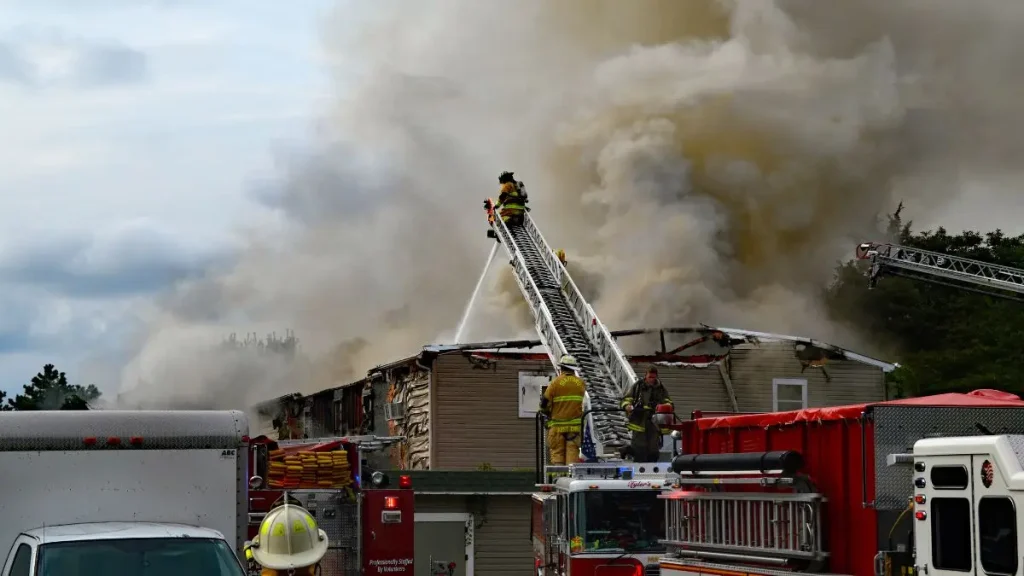One Man Dead After Escondido Home Catches Fire
I still remember reading about this fire, and it hit me how quickly a normal afternoon can turn tragic. On Saturday around 4 p.m., police received multiple calls about a house on fire on South Upas Street near West Fifth Avenue in Escondido. By the time officers arrived, a bedroom was already fully engulfed in flames.
The firefighters worked quickly to control the blaze, but sadly, a man was found dead inside the room after the flames were extinguished.
The scene was chaotic, but the response from both police and the Escondido Fire Department was immediate and coordinated.
Victim Details and Background

According to Patch, the man who tragically died in the fire hasn’t been publicly named. His family shared that he used an oxygen tank to manage Chronic Obstructive Pulmonary Disease (COPD) and was also a smoker.
That combination is extremely risky because oxygen-enriched environments can turn even a small flame into a deadly inferno almost instantly.
It’s easy to read this and think, “That could never happen to me,” but the truth is, accidents like this happen in ordinary homes all the time. Many people don’t realize how dangerous oxygen equipment can be when combined with everyday habits like smoking. In situations like this, a moment of inattention can have fatal consequences.
By knowing a bit about the victim’s life, you can see how preventable some of these tragedies are. It’s not just about reporting the news—it’s about learning from it.
When I think about it, this story is a stark reminder that safety measures at home, even for things we take for granted, are not optional—they’re lifesaving.
How the Fire Unfolded: Timeline and Emergency Response
NBC San Diego reports that police were the first on the scene around 4 p.m. Saturday, responding to multiple calls about a house on fire. By the time they arrived, a bedroom was already fully engulfed in flames.
Firefighters arrived shortly afterward, working as fast as they could to contain the fire and protect neighboring homes.
Despite their best efforts, the fire had already claimed the man’s life. Once the flames were under control, firefighters discovered his body inside the bedroom. The scene must have been horrifying, and it really shows the sheer power and unpredictability of fire.
Arson investigators from the Escondido Fire Department joined police detectives on site to begin piecing together the chain of events. They are examining the scene, talking with the family, and trying to determine exactly how the fire started. In tragedies like this, every detail matters—sometimes the smallest piece of evidence can prevent another similar accident.
Similar to the Tacoma two-story home fire, emergency crews in Escondido arrived quickly, highlighting the importance of rapid response in saving neighboring properties.
Possible Cause: Oxygen Tank and Smoking Risk
From the reports and family statements, the likely cause of the fire was smoking near an oxygen tank. Oxygen itself is not flammable, but it dramatically accelerates combustion. That means even a single spark, a dropped cigarette, or a small flame can become deadly almost instantly in an oxygen-rich environment.
I’ve personally spoken with fire safety experts who stress that this is one of the most overlooked fire risks in homes with medical oxygen. People assume they can smoke safely if they are careful, but oxygen doesn’t forgive mistakes. The room the man was in likely became a flashpoint within seconds, leaving little time to escape.
If you or someone you know uses oxygen at home, there are a few simple precautions that can literally save lives: keep oxygen at least 10 feet away from open flames, establish a strict no-smoking rule, and make sure everyone in the household knows the risks. These aren’t just suggestions—they’re survival rules.
Unfortunately, incidents like this are not isolated; in Alabama, a tragic fire claimed the life of a 5-year-old while a sibling escaped, underscoring how quickly residential fires can turn fatal.
Fire Investigation: What Authorities Are Doing

Even though the immediate danger has passed, the investigation is far from over. Police and arson investigators are meticulously examining the scene to determine the exact sequence of events that led to the fire.
They’re looking at potential ignition sources, interviewing family members, and reviewing the layout of the home and where the oxygen tank was stored.
It’s easy to overlook how much work goes into these investigations. Authorities aren’t just checking boxes—they’re trying to provide clarity to the victim’s family and ensure lessons are learned to prevent similar tragedies. These investigations also help build public awareness and guide local safety campaigns.
Community Response and Safety Awareness
News of the fire quickly spread through the Escondido community, leaving neighbors shocked and saddened. People shared condolences, offered support to the family, and, importantly, started talking about fire safety.
These things show how a single event can spark awareness and action. It’s a harsh reminder that tragedies often serve as lessons for everyone else.
If you think about it, community response isn’t just about sympathy—it’s about learning together, sharing knowledge, and taking steps to prevent future accidents.
Many readers also share safety tips and real-life stories on WhatsApp groups, helping communities stay alert and prepared.
Expert Tips: Preventing Home Fires with Oxygen Use
When I think about this fire, what hits me most is how preventable it could have been. Fire safety experts I’ve spoken to emphasize that oxygen use at home requires strict precautions. Oxygen doesn’t cause fires by itself, but it feeds them—making even a small spark deadly.
Here’s what you can do if you or a loved one uses oxygen:
- Keep oxygen at a safe distance from flames – maintain at least 10 feet from candles, stoves, lighters, and cigarettes.
- Enforce strict no-smoking rules – even a “just one puff” moment is enough to ignite a fire.
- Install smoke detectors in every room – especially near bedrooms and areas where oxygen equipment is used.
- Check your equipment regularly – leaks, cracks, or faulty tubing can increase fire risk.
- Educate everyone in the household – make sure visitors understand the risks of oxygen and fire.
I’ve seen firsthand that people often underestimate these precautions until something tragic happens. Following these rules isn’t overreacting—it’s protecting lives. Even small steps, like moving a chair away from a window with direct sunlight or reminding family members not to smoke indoors, can prevent disasters.
Communities often rally after such events, much like in Southeast Portland, where a house fire left three people homeless, prompting neighbors to step in and provide support.
Key Takeaways and Lessons Learned
Reading about this Escondido fire leaves you thinking: tragedies can strike in the most ordinary homes, and they often involve simple risks we overlook. A combination of smoking and medical oxygen turned a normal Saturday afternoon into a life-ending disaster.
Here are the main lessons we can all take from this story:
- Fires can escalate in seconds, especially around oxygen.
- Small habits—like smoking indoors—can have deadly consequences.
- Emergency preparedness matters: smoke detectors, evacuation plans, and clear safety rules save lives.
- Sharing knowledge matters: talk to friends, family, and neighbors about home fire safety.
If you take one thing away from this story, let it be this: prevention is always better than reaction. Make your home safe, especially if anyone relies on oxygen.
I’d love to hear from you—what steps have you taken at home to make sure a fire doesn’t catch you off guard? Sharing tips and experiences could help someone else avoid a tragedy.
For more real-life home fire incidents and safety tips, check out our Home Incidents section on the website.
Disclaimer: The information in this article is based on reports from local authorities and trusted news sources. It is intended for general informational purposes only and should not be considered professional medical or safety advice. Readers should always follow official guidance and consult experts for personal safety measures.


